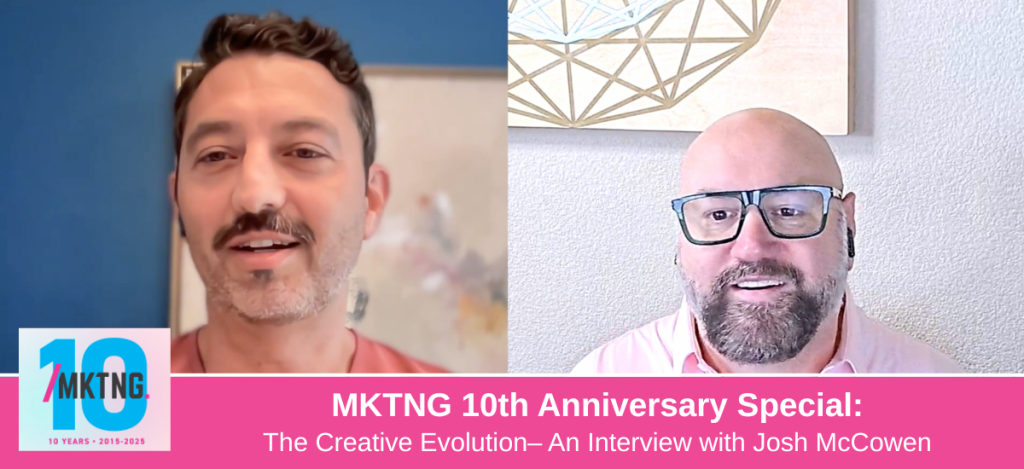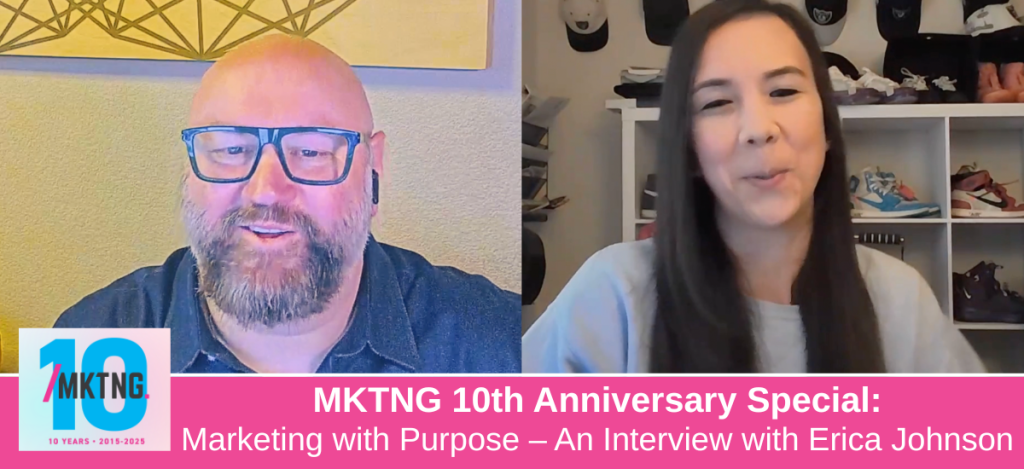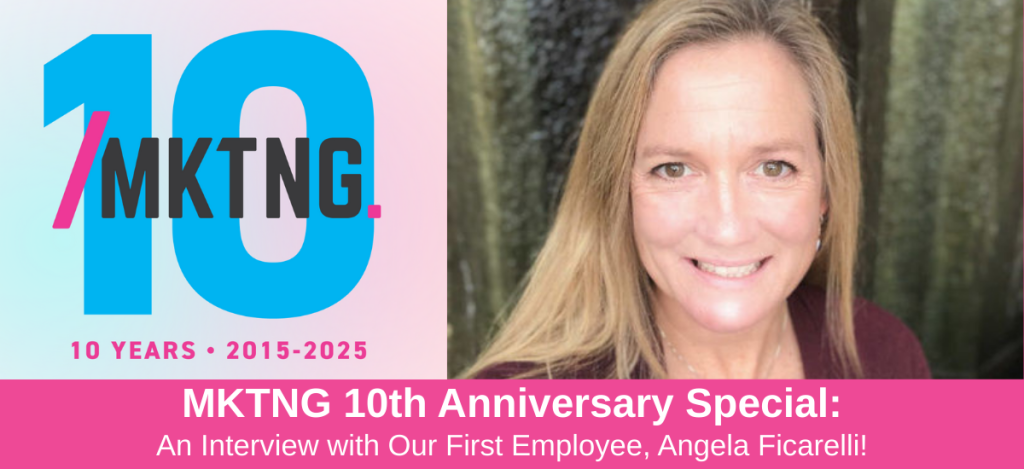MKTNG 10th Anniversary Special: The Creative Evolution – An Interview with Josh McCowen

Host Scott Eggert and Creative Director Josh McCowen discuss the evolving creative landscape over the last decade, noting the massive shift from print design to digital platforms like social media and websites. While embracing the speed of modern tools like Figma and Photoshop, Josh stresses the continued importance of fundamental creative strategy and manual processes, such as sketching on paper, to generate recall and meaningful ideas. The conversation zeroes in on the opportunities and challenges posed by the modern social environment, using the Cracker Barrel rebrand as an example of how public opinion can impact even established brands. They dive deep into the pervasive influence of AI (like Midjourney), which Josh uses as a technical and coding partner, but caution that current AI tends to produce “remarkably average” content and lacks the essential strategic perspective needed for truly great branding. Finally, Josh shares his work on his new venture, A Remembered Life, and wraps up the discussion with a quick “Keep or Kill” lightning round, where he keeps most design concepts but kills Papyrus and direct mail. Key Topics: The Evolution of Design and Marketing The Importance of Manual Creative Process The Impact of Social Media on Branding Defining a Brand AI’s Role in Creative Workflow Limitations and Caveats of AI The Future of Technology in Business Entrepreneurship and New Ventures “Keep or Kill” Design Concepts Personal Creative Pursuits Transcript: Scott: All right. So what does it take to build a brand that lasts? We’re exploring that very question today on the MK ten podcast. I’m the host, Scott Agar, president of MK tag. And I couldn’t think of a better person to discuss this with. And uh, our, my friend and our creative director, Josh McCown, uh, who’s been, uh, fostering, uh, innovation and working with collaborative, uh, teams from doing global brand launches and innovative digital experiences, his work has consistently pushed the boundaries. I can’t wait to dive into the story of creative evolution with him. Josh, it’s great to have you here. Welcome to Mk2 G10. This is a series you put together just to celebrate our ten years, and Josh is a cool part of that story. Cool. Glad to be here. Yeah. Yeah. So, uh, since we’re, you know, ten years, uh, for our outfit here, we, like, we’ve been kind of talking to, uh, you know, everybody on our team, uh, and some previous team members, kind of about what has changed in your tenure, uh, as a designer, what’s something that, uh, you know, you used to do that would just seem archaic, uh, if you were to, you know, pick up that tool or technology and use it today. Josh: I mean, I think the biggest thing for me is, as broadly as it sounds, print, um, which I desperately miss. Um, certainly there’s large brands that still do a lot of print work and, you know, you still see print, but, you know, working with modern tech startups today, a lot of companies, they’re all digital. It’s social media, it’s a website, it’s email. And that’s as far as they take their brand and marketing touchpoints. Obviously brick and mortar shops, things like that, restaurants, you know, anything where there’s a human in person, there’s still going to be some type of collateral. But yeah, I, I wish, I wish more brands to still did print design. Um, that was my initial, uh, endeavor into the design world was illustration and building brochures and annual reports and things like that. Um, but today we we pretty much just do websites and social media and applications and, you know, much more of a digital world these days. Scott: Yeah. Like is there. Are there any tools or a process that you do now that’s just like 180 degrees from how you used to do things? Josh: Um, I’m sure there is. I’m trying to think if there is something that we did like so manually that I got replaced. I mean, obviously we’ll touch on it as the conversation goes on, but AI is changing some of our kind of baseline processes. But I think from a kind of fundamental creative process understanding, uh, discovery process, a lot of the things that we do, or at least I do, I try to kind of maintain some of those best practices from, from before because they weren’t, you know, the tools can help us move faster, but they’re not going to answer our questions. They’re not going to know our insight. They’re not going to be able to pull out some of the things that, you know, you and I and some other, uh, industry people that have been in the around as long as we have the knowledge that we have. So, you know, I maybe don’t sketch as much as I used to on paper, um, when I’m working on maybe collateral or logos and things like that. But, you know, we still use Photoshop. Maybe not as much as we used to in the past. Um, but yeah, I, I can’t think of anything, like, so obvious. And maybe that’s the problem. Maybe there’s something that just it just disappeared, you know, over time. So inherently. But yeah, I, I still love a lot of the manual touchpoints of, of the work. You know, I think that’s one of the things that I enjoy doing the most is the actual creative work, not just the management of it or the direction of it, but actually getting my hands dirty. Um, so yeah, I think. I think my process is maybe the same for the most part. You know, maybe sped up with technology. Scott: Yeah. You mentioned, uh, sketching, which is interesting. Um, probably ten years ago. Right? Like we all thought, oh, we’re all going to start doing that on tablets. Like, did that ever work for you? Did you ever use a digital thing
MKTNG 10th Anniversary Special: A Decade of Public Relations Changes– An Interview with Laura Braden

Laura Braden, a veteran in marketing and strategic communications with 20 years of experience, joins the MKTNG 10 Year Podcast to discuss the evolution of the PR and marketing landscape. She shares insights from her extensive career, including her roles as Director of Communications for the Campaign on Trauma Informed Policy and Practice, Senior Director of Communications for the Sacramento Kings, and Deputy Communications Director for Governor Arnold Schwarzenegger. Laura also founded Girls on the Grid, a prominent Sacramento social scene hub. The conversation covers significant shifts in communication practices, the principles of effective communication, challenges and opportunities in infrastructure project communications, and unique considerations for trauma-informed organizations. The episode concludes with a discussion on the impact of AI and the decentralization of media on the future of strategic communications. Key Topics: MKTNG’s 10th Anniversary Evolution of PR and Marketing Early Social Media Adoption Principles of Effective Communication Infrastructure Project Communications Trauma-Informed Communication Impact of AI on Strategic Communications Decentralization of Media Future of Communications Ethical Considerations of AI Transcript: Scott: All right. Welcome to a special episode of our podcast and MKTNG10, marking our ten year anniversary of MKTNG. Our marketing and PR agency that’s been crafting strategies for brands that care for over a decade. Today, I’m excited to chat with Laura Braden, a valuable team member at MKTNG, and a long time friend whose 20 years of expertise in marketing and strategic communications has made a huge impact in our field. Laura’s career is full of incredible highlights here in in Sacramento and beyond. She currently serves as the Director of Communications for the Campaign on Trauma Informed Policy and Practice. Well, that aligns very closely with our mission here at MKTNG to drive meaningful change through strategic communications. Laura has also left her mark on some pretty defining chapters and the Sacramento region. She served as senior Director of communications for the Sacramento Kings, where she steered all the PR and media for business operations. She also served as deputy communications director for Governor Arnold Schwarzenegger, crafting state, national and international campaigns on economics, infrastructure, energy, agricultural policies. You know that she also founded girls on the grid, once the preeminent hub for Sacramento social scene. Laura has worked for fortune ten companies, political campaigns, state agencies like California medical associations, nonprofits. And she remains a go to consultant for organizations and individuals, often in a time of crisis. I first connected with Laura through my role as president of the Social Media Club a long time ago here in Sacramento. This was when Laura was helping to organize a grassroots effort to keep the Kings here in Sacramento. We’ve remained friends since, and Laura has always remained a source of sharp insights with thoughtful and impactful intentions, which I’ve always valued. Today we’re diving into how marketing and PR well, the landscape has evolved over the past decade and the trends that are shaping our work now and what we see on the horizon. Laura, it’s great to have you here. So let’s jump in. Laura: Thanks for having me. Lovely intro. Yeah. Well, thanks. Scott: All right. So, uh, how are you doing today? Laura: Good. Good. Really ready to dive into some of the things that you and I have been chatting on offline about for a couple of years now. So. Yeah, let’s do it. Scott: Yeah, absolutely. So this is, uh, you know, uh, ten, ten and ten year anniversary for MKTNG, which is, uh, just recently passed. So we’re we’re kind of looking back, right? We want to talk about what’s happened in ten years. And because kind of our careers in general. Right. You both go back a ways. Um, and I wanted to we’ll get to sort of some new tools, right, that are shaping communications. But what’s something, uh, like what’s a relic of your past? Like, what’s a tool you remember using back when, when you were first, uh, starting in public relations? Laura: Well, as you were so kind to say, I am. Yes, almost. I’m approaching my 25th anniversary of being in this world, which is just. Well, that’s an entire lifetime that I’ve been doing this now. So that’s pretty surreal. So as you can imagine, you know, back in, gosh, 2000, 2001 when I got started, one of my favorite things to highlight for folks, especially the younger folks who, you know, don’t really use fax machines and that sort of thing. But, uh, one major thing that has changed is the way that we even distribute press releases and all that. So way back in the day, early 2000, we would fax press releases to newsrooms one by one. We would, um, we would take this was sort of before the internet was ubiquitous. Um, and it was really hard for newspapers, didn’t quite know what the others were covering necessarily. So you could take one off then and we would pitch it at the same time to the Boston Globe, The Washington Post, The New York Times, the Chicago Tribune, all the bigs. And then we would wait for our service to send us in the mail a three ring binder, uh, that op ed placement, as well as any other, uh, you know, media placements for the client. Um, And it would be the actual hard copy from the newspaper cut out posted. And then we would take that three ring binder and make copies of it, and then find it again, and then get it to the client. So as you can imagine, I mean, that’s a lot of jobs, a lot of cottage, you know, little small businesses that it’s supporting because there were probably like four different vendors in that process. But it would take weeks, would take forever. And nowadays, you know, you can’t get away with that. Everybody wants their own unique content exclusivity, especially when it comes to things like
MKTNG 10th Anniversary Special: Marketing with Purpose – An Interview with Erica Johnson

Join us for a dynamic conversation with Erica Johnson on the MKTNG 10 Year Podcast! A true force in marketing and community impact, Erica’s journey is a testament to passion and perseverance. Currently, the Associate Director of Brand Marketing at the American Foundation for Suicide Prevention (AFSP), Erica, ensures the marketing engine runs smoothly, making a profound difference one campaign at a time. In this episode, we rewind to Erica’s foundational days at MKTNG (2015-2016), where she excelled as an Account Executive, managing social media, pitching press releases, and boosting brands like Pottery World and The Big Day of Giving. We delve into her impactful five-year tenure at the Leukemia & Lymphoma Society, where she personally raised over $3.5 million, and her significant contributions to the local PR scene with PRSA. Erica shares insights into her current, newly created role at AFSP, highlighting the unique opportunity to shape the organization’s brand marketing efforts. We explore AFSP’s groundbreaking partnership with the band Papa Roach, which has not only raised funds but also significant awareness for suicide prevention through music and concerts. The conversation touches on the evolving landscape of social media, the rise of influencers, and the burgeoning role of AI, while emphasizing AFSP’s vital work in promoting mental health awareness and safe communication practices, especially among young people with campaigns like “Seize the Awkward.” Key Topics: MKTNG’s 10th Anniversary Erica’s MKTNG Beginnings as an Account Executive Erikc’s transition to brand marketing at AFSP. AFSP’s Critical Mission: suicide prevention and mental health awareness. The impactful Papa Roach partnership for AFSP. Supporting Youth Mental Health: The “Seize the Awkward” campaign. The Evolving Marketing Scene: Insights on social media trends, influencers, and AI’s emergence. MKTNG Memories: Recalling the “Art Hotel” project and the value of in-person collaboration. Erica’s expertise in social media and digital communication. Erica’s commitment to learning and development through the AMA. Transcription: Scott: All right Today we are thrilled to welcome Erica Johnson a dynamic force in marketing and community impact to the MKTNG 10 Year Podcast Erica’s journey is all about passion and perseverance and she’s currently shining as the Associate Director of Brand Marketing at the American Foundation for Suicide Prevention There she keeps the marketing engine humming ensuring seamless collaboration across writing PR social media and production making a real difference one campaign at a time Erica also spent over 5 years with the Leukemia & Lymphoma Society in Sacramento where she raised over $3.5 1000000 But let’s rewind a little bit Erica’s no stranger to MKTNG where she rocked it as an account executive for us back in 2015-2016 managing client social media pitching press releases and boosting brands like Pottery World and The Big Day of Giving Erica was also a part of our art hotel project with DBA Arts and M5 Arts From her early days at Sacramento State to her impactful tenure at the Leukemia & Lymphoma Society and her contributions to the local PR scene PRSA Erica built a career on determination leadership and a knack for connecting people Get ready for an inspiring chat with this er- er- organized upbeat leader who’s all about positive vibes and big results All right Erica welcome All right Erica: That was such a kind introduction I really appreciated that Scott: Well it’s all legit I looked it u- I looked it all up Erica: I do have good history I’ve kept for sure on a lot of my various platforms So I was like- Yeah Wow I have some of this in my notes too Scott: You’ve- You’ve got good PR Erica: Yes Scott: As you should ’cause you’ve been busy I’m so glad to catch up with you and talk more about what you’ve been into ’cause I’ve only just you know We’ve bumped into each other couple times in the last 10 years But- Yep Uh you’ve been up to so much so I’m looking forward to hearing what’s new Tell me a little bit just share right now what’s- what’s going on uh with your current gig Erica: Yeah So I am brand new to a brand new role So it’s really fun to step into a position where no one else has really molded it before So becoming the first associate director of brand marketing is a really cool and special and humbling opportunity for- for me to not only continue to make an impact in the realm of suicide prevention and mental health but also to support my colleagues and my fellow chapter staff members as someone who came from the fundraising volunteer development side as an area director So it’s really helpful to have a lot of that context and information like on the ground um with the community and being able to bring that to our c- national communications and marketing team Um so it’s been a really fun last I think it’s been now like 5 or so months um but it’s been over three and a half years or so at AFSP So it’s gone by fast It feels like it could be longer But it’s definitely been a really great place to grow and such inspirational and passionate people both the people I work with as well as the folks that we get to work with as volunteers and board members Um so it’s just a really uh special opportunity and moment I feel like in my career So I’m really excited about it Scott: Yeah And I’ve seen you guys have had like s- a well a cool partnership that I saw uh just late last year uh with Concerts in the Park even right That you guys- Oh yeah had a thing with Papa Roach and uh- Yes and a song like Was that song that he wrote uh I- I saw like he was donating proceeds was that with your- your organization Erica: right It was I was not able to be at that Concerts in the Park I was
MKTNG 10th Anniversary Special: An Interview with Our First Employee, Angela Ficarelli!

Join us as we celebrate MKTNG’s 10th anniversary with a special interview featuring our very first employee, Angela Ficarelli! In this episode, we take a trip down memory lane, discussing the early days of MKTNG and Angela’s pivotal role in building our client relationships and innovative strategies. Angela, now the marketing and business development director at Hilltop Radiology, shares her experiences and insights from her time at MKTNG, including memorable projects like the Stache Bash event at Palladio. We also dive into her current work, which focuses on personal connections and storytelling, and discuss her thoughts on the future of marketing in the age of AI. We explore how Angela continues to use the lean philosophy and social media calendar from her MKTNG days and her excitement for integrating new technologies like RingCentral and AI bots. Plus, she shares her favorite AI tools, including Grok, and her latest discovery of comfortable and stylish Earth shoes! Don’t miss this insightful and engaging conversation as we celebrate a decade of MKTNG with one of our founding members. Key Topics: MKTNG’s 10th Anniversary Early days of MKTNG with first employee Angela Ficarelli Memorable projects like Palladio’s Stash Bash Angela’s current role at Hilltop Radiology Marketing strategies: Personal connections vs. technology Using lean philosophy and social media calendars Future of marketing and healthcare with AI Favorite AI tools: Grok, ChatGPT, Gemini Product recommendations: Earth shoes Experiences with early social media and its evolution Transcription Speaker 1 [00.00.21]: Today, we are thrilled to welcome a very special guest to Mk G10 Angela Ficarelli. The one and only our very first employee here at Mk TNG. Angela joined us a decade ago back when we were just getting started. Angela came to us having been a co-founder of another digital marketing shop. She served MK as a director of Client services, where she built client relationships and drove results with innovative strategies. Angela has always had a knack for staying ahead of the curve. Over the years, she’s worked with an incredible range of brands, from luxury tile galleries to mortgage firms, and now, as marketing and business development director at Hilltop Radiology, she’s crafting authentic, story driven experiences that connect people to brands in meaningful ways. Angela’s passion for marketing. Her creative warrior spirit, and her ability to navigate this ever evolving landscape make her the perfect person to feature in our trip down memory lane. So let’s dive in. Angela, welcome back to the MKE TNG family, even if it’s just for the next 45 minutes. Speaker 2 [00.01.34]: Well, thank you so much. What a wonderful introduction. I appreciate that. Woo Speaker 1 [00.01.38]: hoo! Well I, you know, I, I we could spend 45 minutes. I just glow about you because I really enjoyed working with you. It was fantastic. Speaker 2 [00.01.48]: It was definitely a good time. It was definitely a good time. We were going through a lot of the same things at the same time as well, so it was definitely Speaker 1 [00.01.56]: a rush. Yes. Right. Yes. We get into all the history, but that was, uh. Yeah. Uh, you ended up living near each other and the kids were the same age, and, uh, we saw all the things, um, so pretty nuts. But, uh, let’s talk about what you’re up to now. What? Tell me about your current gig and and what you’re doing. Speaker 2 [00.02.22]: So I’ve pretty much been with Hilltop Imaging, where, um, we have three facilities, uh, in the Sacramento area. Well, one in Elk Grove and one in Roseville, and then one is in the Bay area. It’s under the umbrella Hilltop imaging. Um. And I’m the marketing director. I really do a lot of, uh, in person. Uh, in person, like 1 to 1 connections as well as, like, spoiling, spoiling people from, uh, with, you know, coffee dates and, and food and, and really sort of, um, trying to get that, that connection with them so that we can talk personally. Um, and, you know, it’s a little bit more of an emotional connection, uh, with our facility. Um, so, I mean, that really that’s kind of in a nutshell, what I do right now, which is completely different from what I’ve done in the past in terms of marketing. I started in traditional and then moved into digital. And so, uh, this is like a breath of fresh air because I feel like this is a part of me that’s, uh, that that’s really the part of me that comes out that is really, really Speaker 1 [00.03.35]: good. Right? Well, what I like. I like that your your job is very people centric, it sounds like. Right. Yes. And it’s funny when we talk about marketing, there’s just. Just for one. Very few people even understand what marketing, you know, means. Um, but you have people who do marketing, and it’s. I’m. I’m writing a response to an RFP for the government. Right. And they’re and they’re marketing people, but they sit at a computer all day and type thing, right? Uh, they’re really weird people. Um, and then, uh, and then there’s, you know, what we do here at McTeague, which is words and pictures and, you know, telling stories. Um, and it really is about, like, taking a brand and putting it in front of the masses. Um, and then there’s what you’re doing, which is like doing, you know, one on one, like going and relating to people and telling, telling them the story in person. Like kind of embodying the brand. Mhm. And going in. Yeah. Educating and storytelling. Speaker 2 [00.04.45]: So I, I do, I do provide. Um just so you know, I do provide um graphics. Like I’ll, I’ll come up with different graphic pieces which can be my like conversation starters with, um, when I’m in front of those people. It provides just
The Big Hit: Why Media and Podcast Coverage Is Just the Beginning

National media coverage can feel like winning the PR lottery. There’s nothing quite like telling a client, “We landed the Washington Post” or “CNBC wants you on tomorrow” or “Joe Rogan read your book, when can you fly to Austin?” The celebration emails fly, champagne corks pop, and for a moment (and just a moment), you feel like you can do anything. And seasoned communications professionals know a crucial truth: securing coverage is just the first step. What you do next determines whether that media moment becomes a lasting asset or a fleeting victory lap. This has never been truer, as all news seems to be breaking, the 24/7 news cycle feels like a distant memory, and distrust of (corporate) media is at an all-time high. The most popular podcasts are constantly releasing new episodes, and there are no shortages of platforms to consume content. The Amplification Imperative A national media or popular podcast hit without an amplification strategy is like catching lightning in a bottle—then leaving the cap off. Without a plan to extend and leverage that coverage, even the most impressive placements quickly fade from public consciousness. I like using the “before, during, and after” mindset: Before: Prepare your digital infrastructure for increased traffic. Is your website ready? Are conversion pathways clear? Do you have follow-up content ready to engage new visitors? What’s the call to message? Have you created a summary blog post (linking back to the media/podcast source)? During: Create a real-time amplification plan across owned channels. How quickly can you share the coverage? Which stakeholders need immediate notification and on which platforms? Which media and podcasts should receive an ICYMI (In Case You Missed It) to spur new interviews? After: Develop a strategic repurposing calendar. How evergreen is the content? How can this coverage feed your content ecosystem for weeks or months to come? Should you record a corresponding video and/or podcast to go deeper on the subject? Each piece of coverage should serve as a building block for your next opportunity. A thoughtful approach includes: Using coverage as third-party validation in future pitches Creating content packages that combine multiple pieces of coverage to tell a cohesive story Identifying related angles that weren’t covered in the original piece for follow-up pitches Leveraging timely national conversations (even those not mentioning your organization) to secure local commentary opportunities The Multi-Directional Media Flow Perhaps the most overlooked aspect of media relations is understanding how stories travel between different tiers of media and podcasts. Generally speaking, you have hyper-niche/local, niche/local, statewide, regional, national, and international, and industry/sector. Whew! Coverage doesn’t just flow downward from national to local—it moves in all directions: Local to national: Regional stories with broader implications frequently get discovered by national producers scanning local outlets Industry to mainstream: Trade publications often serve as research sources for mainstream reporters looking for emerging trends Digital to traditional: Social conversations and digital-first content regularly spark interest from legacy media outlets This multi-directional reality creates strategic opportunities for savvy communicators. Owning your local media market isn’t just about regional visibility—it’s often the most effective pathway to future coverage that reaches and expands your targeted audiences. The Bottom Line Don’t measure success by the prestige of the placement alone. Evaluate media and podcast coverage based on how effectively it advances your strategic objectives and how successfully it’s integrated into your broader communications ecosystem. When approached with this mindset, even “smaller” placements can deliver outsized impact, while seemingly impressive national hits might underperform without proper amplification. The question isn’t just “Did we get covered?”—it’s “What did we do with the coverage we received?”
